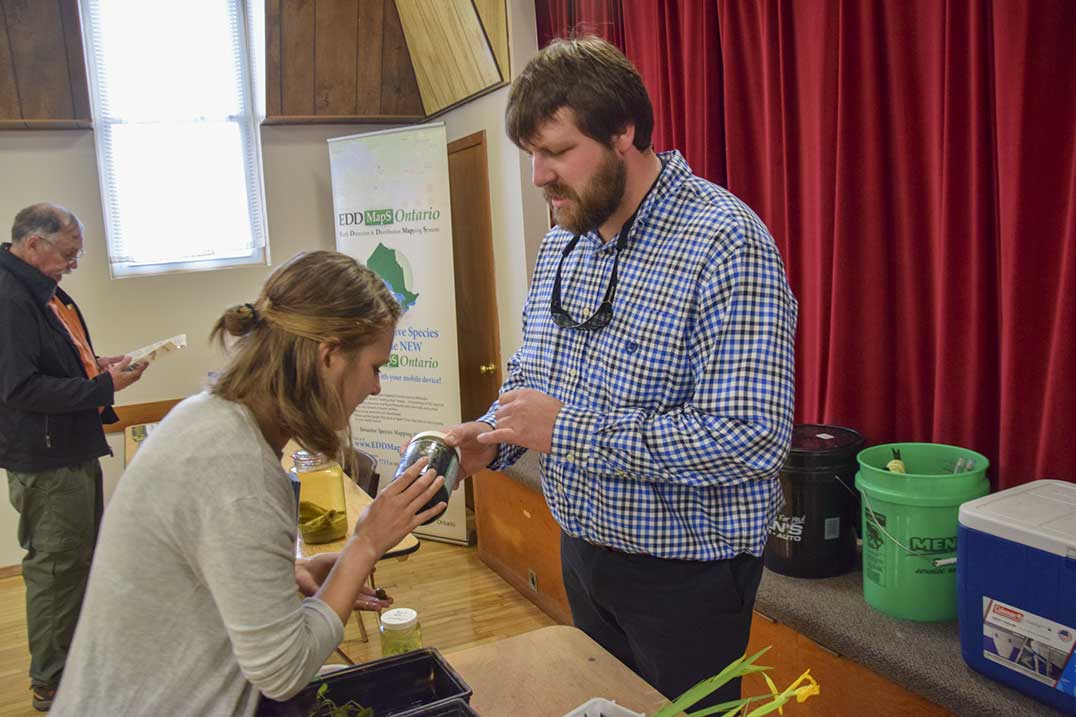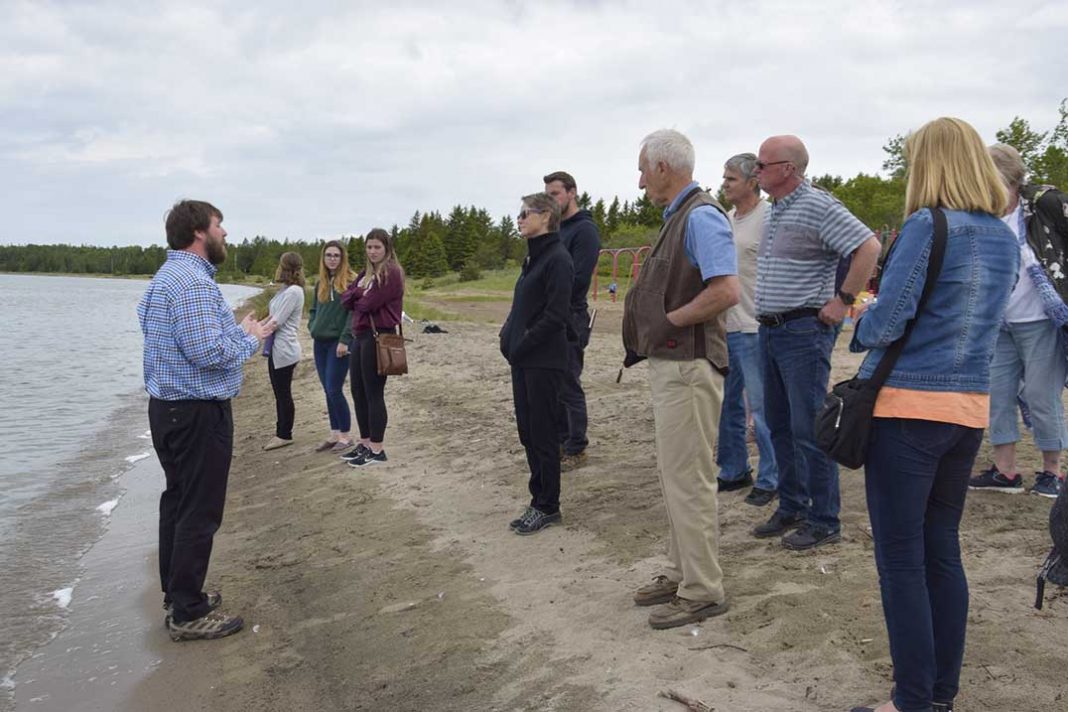PROVIDENCE BAY – Early detection and control efforts are the key to defending Manitoulin’s shores from the depredations of invasive species. To that end, the folks at the Early Detection and Rapid Response Network Ontario (EDRRNO) hosted an Aquatic Invasive Species Manitoulin training workshop at the Providence Bay Community Centre recently.
The five-hour session ran from 9 am to 2:30 pm on Wednesday, June 19 and covered a wide range of alien invaders that either have arrived on our shores or whose imminent arrival is anticipated in the coming seasons. Those species run the gamut of invasive plants, including the pervasive foe phragmites, (an invasive reed that is already heavily impacting some of the Island’s beaches and waterfront properties) as well as milfoil and the European frogbit; to aquatic invasive invertebrates such as the rusty crawfish, quagga and zebra mussels; and extending to the four species of Asian carp, only one of which is currently confirmed to have been found in Great Lake waters.
The facilitator for the workshop was Gaby Nichols of the EDRRNO, who noted in her opening welcoming remarks that the purpose of the workshops was to “attempt to train people like you to recognize invasive species” and to provide some kind of arsenal of effective responses.
The first presenter at the workshop was Lauren Bell, education and community outreach co-ordinator with the EDRRNO’s Invasive Species Centre. She explained that the workshops in the Algmoma-Manitoulin catchment area were made possible thanks to a grant from the Ontario Trillium Foundation.
“It is all about moving out of the traditional view of scientists in white coats in laboratories,” she said. “There are just not enough resources for that to be effective. We work with anyone who is interested, people such as yourselves, who can be feet on the ground in the front lines of the battle against invasive species.”
Through the use of handouts, courses, workshops and in collaboration with the Canadian Food Inspection Agency the invasive species project began with a process aimed at defining what the workshops should focus on.
“We want to know what the next emerald ash borer might be and get ahead of the curve,” said Ms. Bell. Getting ahead of the curve is vital if preventing the spread of a destructive invasive species is to have any hope of success. It is a tricky business to define those invaders as many can lay relatively dormant for many years before some incident or factor causes them to explode upon the environment.
“As to why Northern Ontario, this part of the province, has a lot of high traffic with a lot of people coming in from other regions of the province,” she said. “Ontario has the highest number of invasive species in Canada.”

The battle plan is to utilize a number of different types of workshops, with education and callouts focussing on the general public rather that some kind of removal service.
“We took big blocks from the Ministry of Natural Resources and Forestry documentation and made them into smaller, more focussed brochures on best practices,” said Ms. Bell. “The key challenges are that we are dealing with a volunteer network and inducing and maintaining interest—providing a tangible call to action.”
The first line of defence is to train willing and engaged volunteers to recognize invasive species and get them to check and report on what is happening in their own back yards.
“That is how you can help,” she said. The two pilot projects underway are taking place in the Sudbury and Sault Ste. Marie regions. She encouraged people to get on to the group’s mailing list. Everyone can take on a role.
“Maybe your interest isn’t being out on the landscape,” she said. “But if you pay attention to what is going on around you, maybe that something you normally see around you is starting to die, maybe you are seeing something that you have never seen before.” By reporting those little changes in your local environment you can add to the knowledge base and help bring a rapid response to eradicate and control the invasive species before it gets out of hand.
“So we are taking people back to basics,” said Ms. Bell. “First off, what is a native species?”
Generally, in a broad sense, that is a species that existed here before the advent of European settlement. An invasive species is an exotic visitor that has a negative impact.
There are alien species that do not have a significant negative impact on the environment, some might even have benefits or at least a net positive. The invasive species the workshops are focussed on do have negative impacts, however, whether they are environmental, economic or social in nature—many have components of all three.
Ms. Bell used the example of phragmites, an invasive Asian reed that grows extremely high and dense, with tough impenetrable stalks that not only push out the native species like cattails, but also impede the fish habitat and turtle reproduction. As an ecological impact, phragmites creates a monoculture. Giant hogweed, on the other hand, can cause immense suffering to those who come in contact with it, limiting enjoyment of the land. The emerald ash borer has devastated huge tracts of forest after being imported into the US in untreated wooden pallets.
Sometimes it might seem that invasive species are an unstoppable wave, but there have been numerous success stories to provide hope.
Often those successes are attributable to the early detection of the invasive species. Ms. Bell cited a case of infestation by the Asian longhorn beetle which was eradicated thanks to a rapid response to the threat.
Robert Canning, of the Severn Sound Environmental Association, took the workshop attendees through the four types of aquatic plants: algae, floating plants, submerged plants and emerged plants. Each, he noted, depends on access to light, nutrients and habitat, in that order.
“We humans are the best thing that ever happened to invasive species,” he said, pointing out that human travel is the key component in the spread of invasive species. “We move more plants to places they will never get to naturally,” he said.
There are 10-15 aquatic invasive species in Ontario, noted Mr. Canning. One of the key plants currently being focussed on is the Eurasian water milfoil. Key elements in identifying the invasive version from the native variety is that the Eurasian version, which has 12 or more “braids” in its leaves, as opposed to the native variety which has less than 12. Complicating matters is that the two species create a hybrid that has elements of both.
Then there is curly leaf pond weed, an early season plant that disappears beneath the surface, only to reappear in the fall.
Many of the plants arrived here as ornamental pond or garden plants. One of the key methods in preventing the spread of aquatic invasive species is to learn to identify and report them, never buying or keeping invasive species, don’t release invasive aquatic plants into Ontario lakes, rivers or streams, and, very important—clean, drain and dry your boat, trailer and equipment. “Remove all plants, animals and mud and dispose of them on dry land or in the garbage,” he said. “If you see an invasive aquatic plant in the wild contact the toll-free species hotline at 1-800-563-7711, online at EDDMaps.org/Ontario or by email at info@invadingspecies.com.”
Kate Powell, terrestrial invasive species outreach liaison at Ontario Federation of Anglers and Hunters (OFAH) provided an overview of invasive crayfish, such as the rusty crayfish that has invested the Kagawong River. The rusty crayfish is native to Ohio and was first spotted in Ontario in Peterborough in the 1960s and an invasive snail that is starting to appear locally. The familiar quagga and zebra mussels were also discussed.
Everyone is pretty much familiar with the horrifying sight of massive Asian carp flying out of the water at the approach of a motorboat, but only one of the four Asian carp species does that, and for some as yet unfathomable reason the silver carp does not do that in its home waters.
“They don’t jump in their native range, only here in North America, we really don’t know why,” admitted David Nisbet, partnership and science manager with the Invasive Species Centre.
He noted that the four species of carp referred to are known collectively as Asian carps, including the black, bighead (which can grow to a massive four feet), the aforementioned silver and the grass carp.
Two of the key identifying characteristics of the Asian carps are that they lack the barbels (hanging feeler-like protrusion from the lip) and that their eyes generally lie below their centreline or, like the grass and black carp, near the centre. The native-ish common carp has eyes more towards the top of its head.
Asian carps (not a typo, they are referred to this way as a group of different carp species) could have a number of detrimental impacts should they ever establish into the Great Lakes or their watersheds. Black carp will threaten native mussel populations (they grow to as much as two metres in length), bighead and silver carp continuously feed on plankton and reduce water quality and the grass carp destroys wetlands and alters habitats (and can consume 40 percent of its body mass in food daily). All of these species outcompete native species for food supply. The silver has the added threat of the aforementioned habit of jumping out of the water where they can injure recreational boaters. Nearly all of the carp spotted in the Great Lakes have proved to be sterile, an indication that they escaped from aquaculture operations.
Oddly, the common carp is also a foreign invader but has been established in North American waters for upwards of 200 years and has found its niche in the eco-system.
Getting to these fish early is very important. “If they get established they will be almost impossible to remove,” said Mr. Nisbet.
Seija Deschenes of Manitoulin Streams gave an overview of the successful Phragmites Project being run by Island biologist Judith Jones. The program is in the third year of its three-year run and has focussed on working with volunteer groups and waterfront property owners in identifying and eradicating the pernicious weed.
This year the project’s major focus will be in South Bay July 29 to August 1.
The final presentation was by Ms. Bell on the European frogbit, a small free-floating plant about the size of a 50-cent piece (if anyone remembers how big those coins are, about 1.5 times bigger than a quarter) and resembles a very small lily pad. The plant prefers a location with low wave action, such as bays or inlets and ditches and reproduces via fragmentation. The frogbit has been spotted in the St. Mary’s River on the US side, but invasives are not noted for respecting borders.
To learn more about invasive species, visit the invasivespeciescentre.ca website or to report an invasive call the hotline at 1-800-563-7711, online at EDDMaps.org/Ontario or by email at info@invadingspecies.com.






